
Yue Green Wares
Zhejiang Yue kilns have a long tradition of greenware production which based on archaeological evidence could be traced to at least the Zhou period. After a long period with intermittent disruption and chaos caused by wars, the potters finally produced a mature form of greenware by Eastern Han period. The quality of the products continued to improve during the ensuing Jin Dynasty. From 402 A.D the Jin were succeeded by a series of short-lived dynasties. Political instability resulted in social chaos and the decline of the Yue kilns.
Production picked up again during the Early Tang Dynasty. Tea drinking became popular and boosted huge demand for the related vessels, such as bowls and ewers. By the Mid Tang period, Yue wares again established its reputation as the premier porcelain product. In Cha Jing (茶经), ie treatise on Tea, Lu Yu (陆羽) commented that Yue ware was the best and most suited for tea drinking. The best Yue ware was called Mise porcelain, literally meaning secret colour porcelain. The ware was highly regarded and widely praised by the literati since the Tang Dynasty. Lu Guimeng (died A.D. 881) in his poem "秘色越器" Mise Yueqi (secret colour Yue ware) mentioned that Yue wares were fired in misty and windy autumn and described the colour of yue ware as "green from trees despoiled from thousand peaks".
The main production sites were located in Zhejiang Shangyu and Cixi Shanglin lake, with the latter finally emerging as the centre of production. The finished products could be transported to the port of Mingzho (Ningbo) and ferried along the coastal route to major commerical centres such as Yangzhou and Guangzhou. It could also be exported directly overseas from Mingzhou. Archaeological excavation of the ancient port sites uncovered large numbers of Yue fragments.

During this period, there was further improvement in the production technology. Saggars were introduced and the insulation during firing improved the quality of the vessels tremendously. The glaze became even and glossy. The potting of the vessels were also superb. The influence of contemporaneous gold/silver vessels on the form of Yue wares is apparent. Indeed those from the Belitung wreck are representative of the unsurpassed standard of craftsmanship attained by the potters. Although the glaze has degraded due to exposure to the sea wate, its excellent workmanship is apparent. The form is elegant, well-form and thinly potted.
Most of the Yue wares from the wreck are of utilitarian nature, such bowls and cups for food and drink consumption, vessels for water such as ewer and jars, sanitary vessels such as incense burners and cover boxes. Asesthetically, the emphasis and focus is elegant form and silky glossy glaze. From kiln and ancient arachaeological sites, it is noted that most vessels were intentionally left plain as decorative embellisement may only act as a distraction. Only a small number were decorated with unobtrusive shallow carved/incised decoration. The shallowly carved line surface is slightly angled. This decorative technique was predominent during this period. By the late Tang period, solely fine incising was in favour till Northern Song period. In terms of proportion, the number of vessels with decoration found in this wreck is surprisingly large in number.

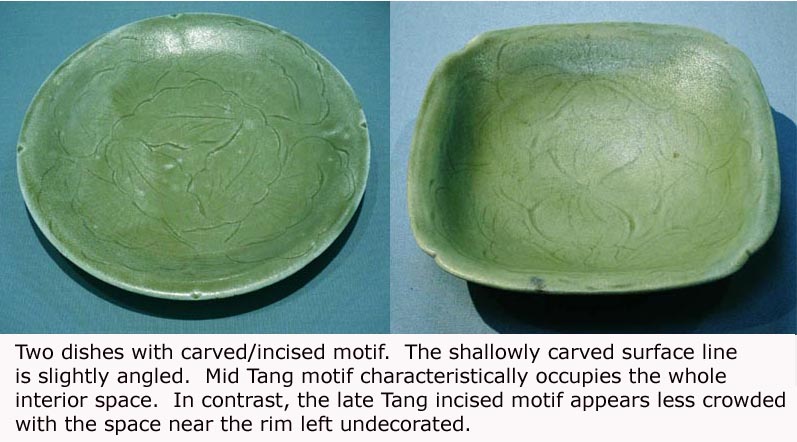
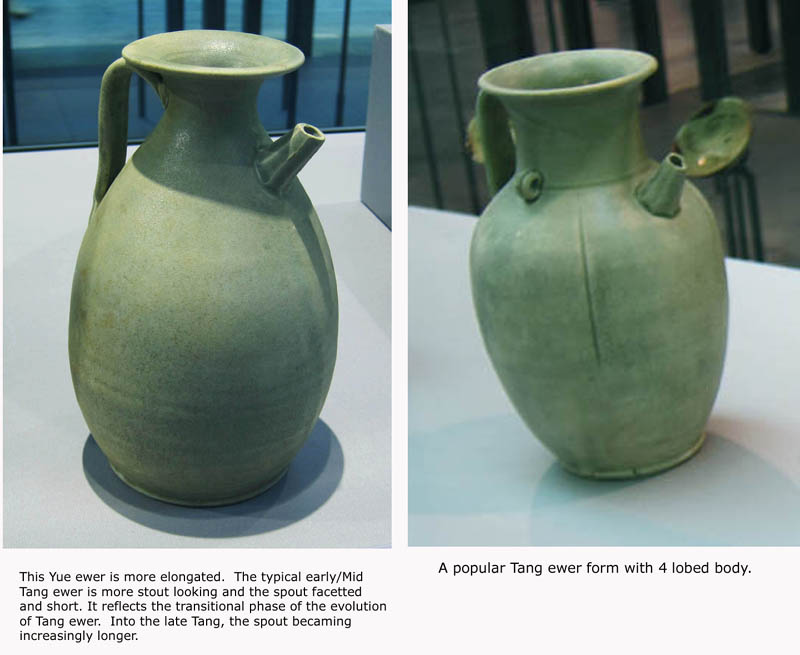
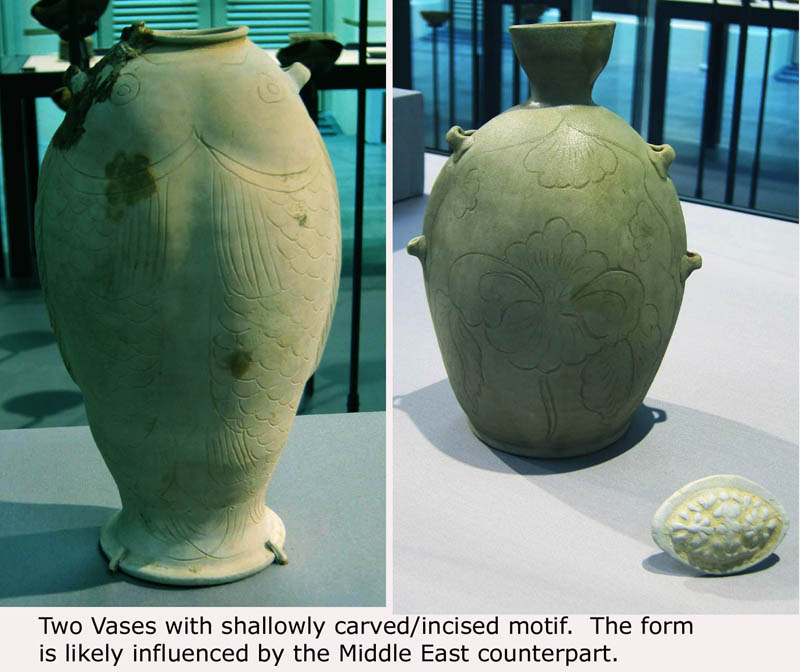
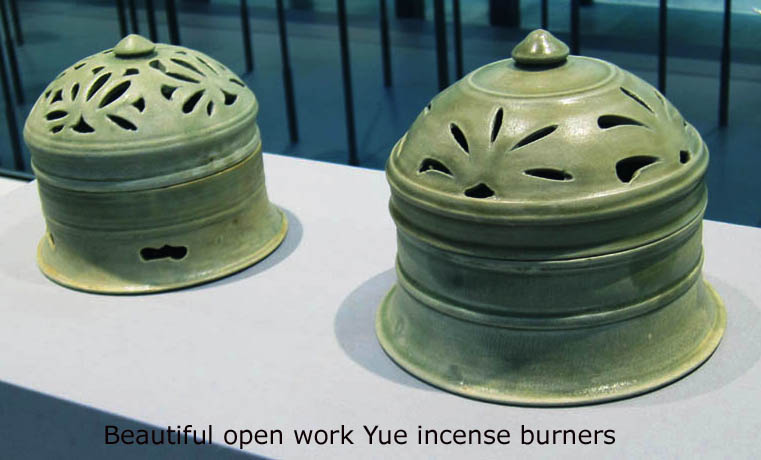
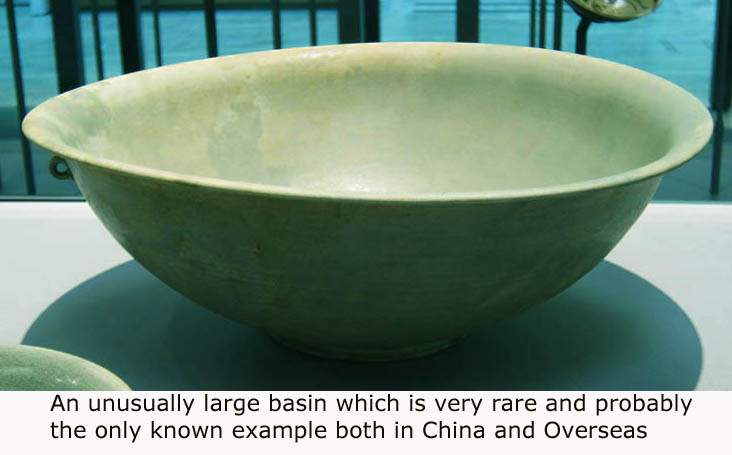
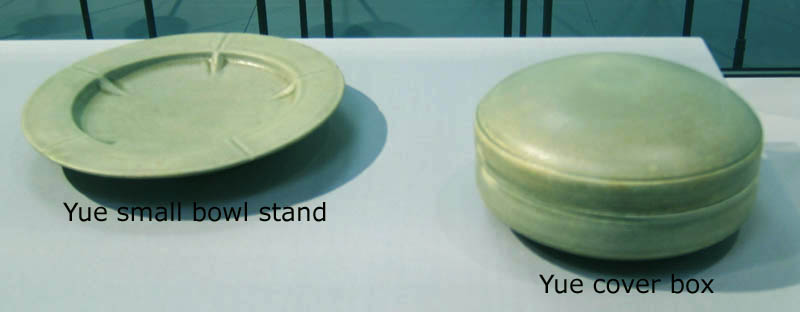
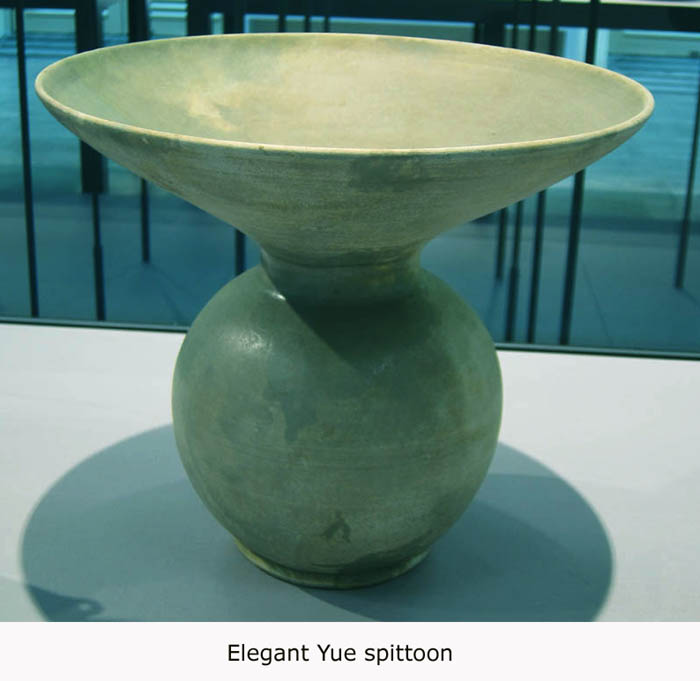
Short video clip of the Yue wares in the Belitung wreck can be viewed here.
Northern China Xing and Gongyi White Wares
Xing white ware represented the highest standard of white ware production during the Tang Dynasty. Lu Yu (陆羽) in his treatise on tea (茶经) compared Xing white glaze to silver and snow (若邢瓷类银, 越瓷类冰). It's popularity was noted in the ancient historical text (国史补) by Li Zhao (李肇) who commented that Xing white wares from Neiqiu (内丘) (one of the main production Xing ware production site in Hebei) were used by the rich and poor (内丘白瓷瓯, 端溪紫石砚, 天下无贵贱通用之). Mid Tang was the peak production phase for Xing wares. In terms of varieties and quality of the vessels, this was the golden period for Xing wares. Many of the items such as bowls, cups and plates were thinly potted and emulated shapes found in Middle Eastern gold and silver wares. This borrowing of form from another medium was not unique to Xing but also adopted by other kilns such as Yue and Yaozhou. We can get a glimpse of the highly accomplished skill of the Xing potters through the Xing wares found in the Belitung wreck. Indeed it mirrored the description as found in the ancient texts. The glaze is snow white and the vessel form both thin and elegant.
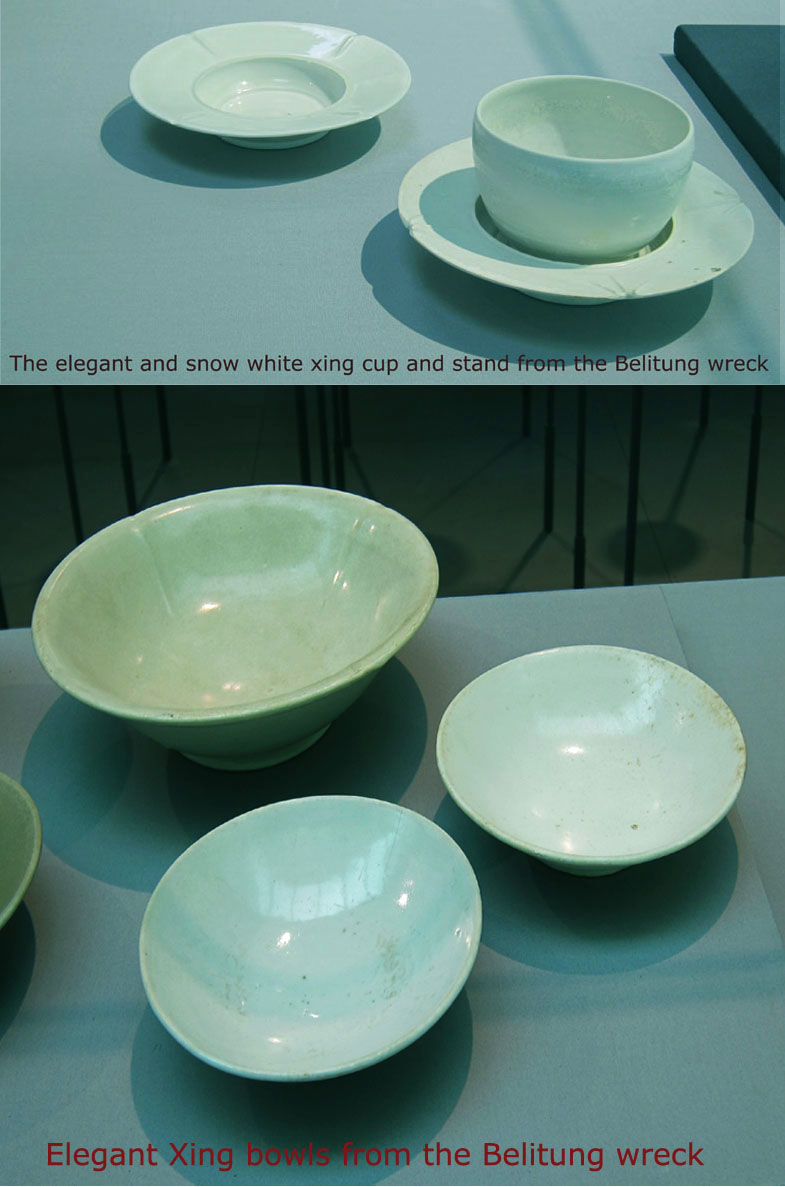
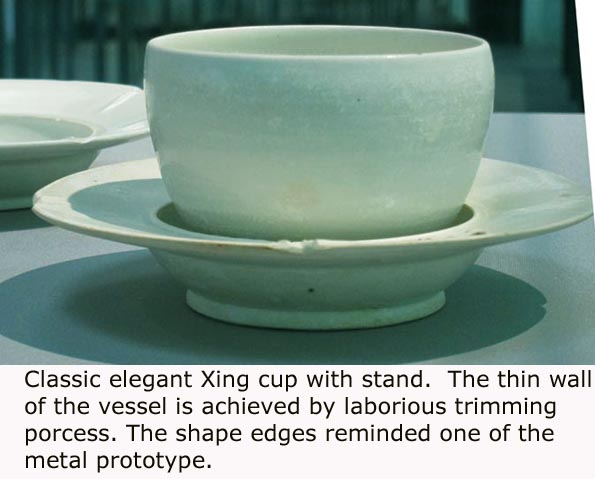
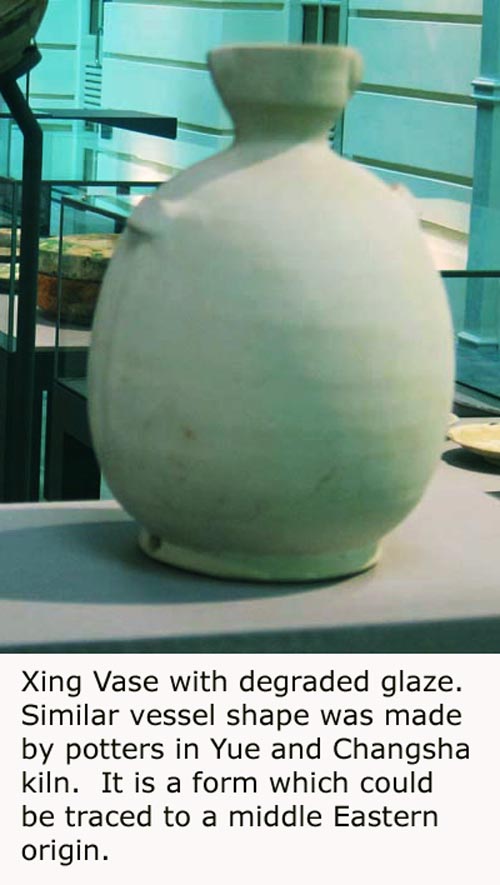
Majority of the white wares from the wreck are most likely from the Xing kiln. However, there are some which are likely from the Gongyi (termed Gongxian in the past) kiln. Henan Gongyi kiln was the largest and most famous site for production of Tang lead-glaze sancai wares. However excavation survey also revealed it produced large quantity of white wares. Gongyi white wares are usually more crudely potted without additional or minimal trimming processing. The body is covered with a layer of white slip before glazing. Hence, the glaze does not fuse well with the body and is susceptible to flaking. The glaze is typically of a creamy colour tone. Compared with Xing wares, the paste is not as dense and more porous.
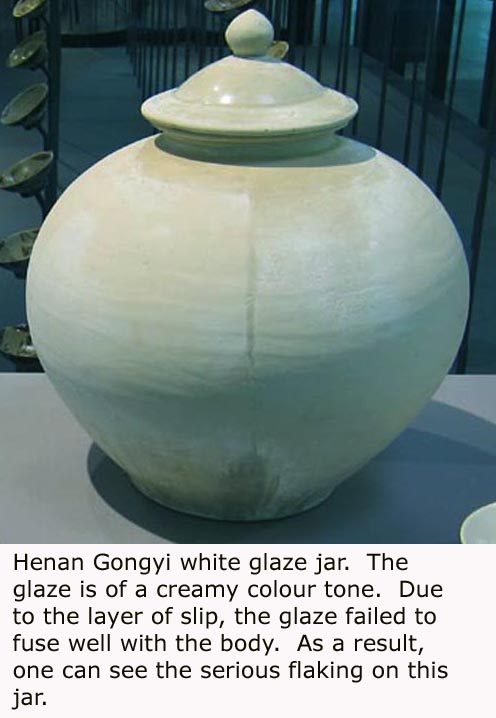
Tang Blue and white wares
Among the cargo, 3 Tang blue and white feature as one of the most important find. They are exceptionally rare as no other complete example are known to exist till now. We only know about the existence of such wares during Tang Dynasty when some fragments were recovered in Yangzhou in 1975. It raised much excitement as blue and white was generally held to be first produced during the Yuan Dynasty. The decoration clearly shows Middle Eastern influence with decorative elements such as lozenge and palmette foliage. The final product looks experimental and the standard of painting rather mediocre. Henan Gongyi Baihe kiln (巩义白河窑) was finally confirmed to be the production site after some fragments were recovered during archaeological excavations in 2005. Obviously the scale of production was small. It was likely a temporal experimentation and production ceased due to poor reception in the Middle East market. The cobalt used to produce the pigment is likely imported from the Middle East region. Cobalt was also used to produce the blue colour found on Tang Sancai. The Middle East potters were known to produce cobalt blue decoration on their pottery since the 9th century. We are still unable to determine who produced the blue decoration first. Did the Tang potter learnt from the Middle East potter or vice versa? Ironically, 500 years later it was again due to Middle East demand that mature blue and white white wares were finally produced during the Yuan Dynasty. The Tang potters would not have foresee that it would turn out to be the most iconic Chinese porcelain.
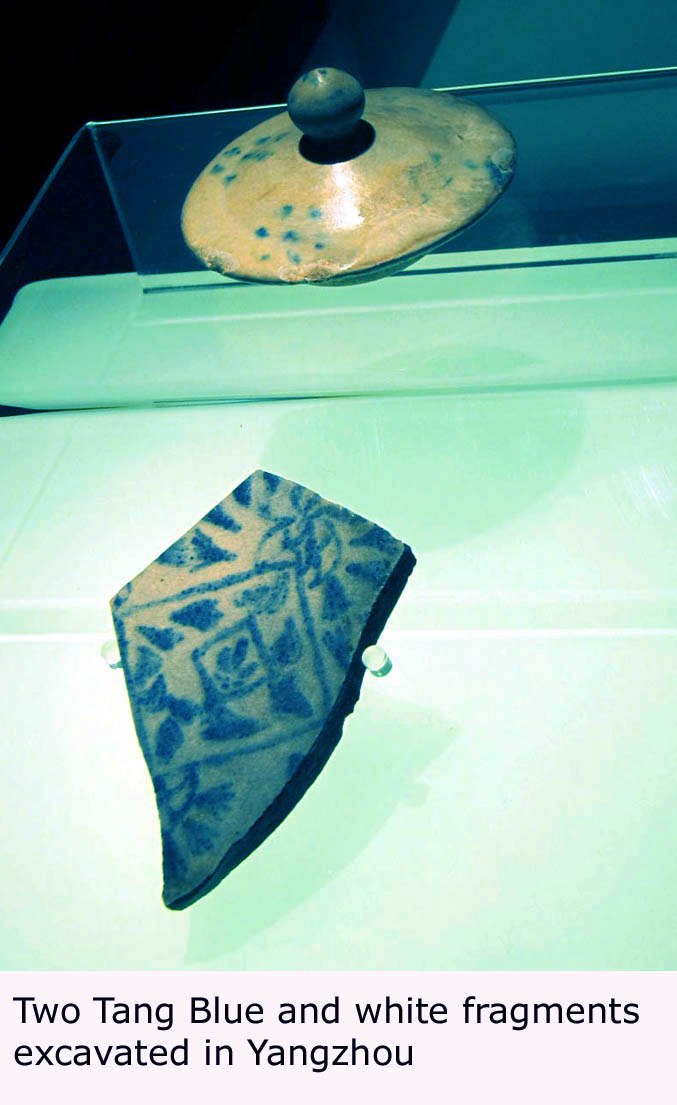
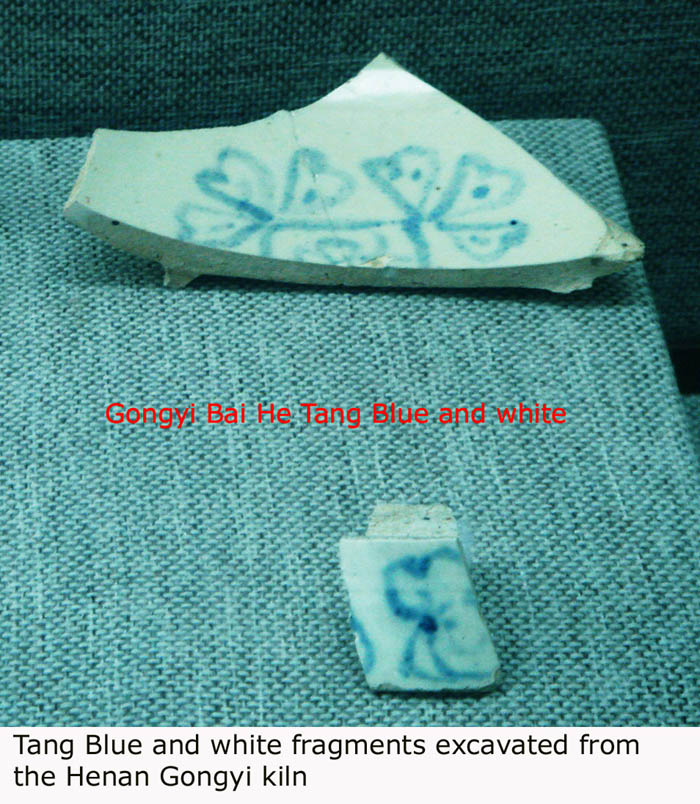
A short video clip of the 3 Tang blue and white plates can be viewed here.
Northern China White ware with green splashes
Among the cargo, there is a group of white vessels with green splashes. It is actually low fired lead glaze and the glazing technology is similar to Tang Sancai wares. Lead glazed green pottery was first produced in Northern China during late Western Han and widely widely believed to have originated in Guanzhong (关中)in Shanxi (陕西). It was a widely distributed ware during Han Dynasty. Production decline after the collapse of the Han Dynasty. Interest was revived during the Northern Wei period period. Instead of the reddish earthernware body, the lead glaze was applied on white porcelaineous white body material. The final product required two firing processes. Firstly, the biscuit was fired to around 1100-1200 degree centigrade. Lead glaze was then applied and the vessel went through a second firing of around 900-1000 degree centigrade. Besides lead green or amber monchrome glazed vessels, another new variation with transparent straw white glaze further decorated with green splashes was introduced. A number of elaborately decorated lead-glaze vessels were found in tombs of the the Northern Dynasty Beiqi (北齐) period. The form of the vessels showed strong Central Asian influences. The assimilation of certain degree of culltural elements from the western region was grounded in historical development after the collapse of Western Jin. Northern China was invaded by the 5 Barbarians (五胡) who established their own kingdom in the 4th centuries. The peoples categorized as the Five Barbarians are the Xiongnu, Jie, Xianbei, Di, and Qiang. They were a mix of tribes comprised mainly of Mongolian, Turkic and Tibetan stock. Eventually, the Northern Wei of the Xianbei stock conquered the rest of the northern states in 386. A processs of sinicisation was initiated with the babarians adopting many aspects of the Chinese culture. Inter-racial marriages also resulted in certain degree of racial integration and acceptance of foreign culture. There were increased contact with Central Asia and mutual cultural exchanges. The adoption of Central Asian form and decorative elements in Chinese ceramics is a testament of the exchanges. Two examples, one an amber glazed flat hu vase from the tomb of Fancui (范粹) and a light yellowish glaze jar with green splashes from the tomb of Li Yun (李云) are shown below.
Two lead-glazed vessels with Central Asian influenced form
This cultural and trade exchanges reached its climax during the Tang Dynasty. The capital Chang an became the most cosmopolitan city in the world. It was fashionable for the upper classes of the society to wear clothings and enjoyed sports and music introduced from Middle East and Central Asia. Many of the vessels, including those made in ceramcis, showed foreign influences in terms of form and decoration. Some were used locally and others exported. The distinct Middle East and Central Asian influences found in the ceramics from the Belitung wreck is testimony of the cultural and trade exchanges.
The above straw colour vase with green vertical splashes is clearly precursor of the Belitung green splashes vessels. In fact, lead-glaze technology was further developed with more variety of colour glazes. This multi-coloured glazes on ceramics vessels is termed Tang Sancai. Tang Sancai wares were mainly produced for burial purposes as lead is a poisonous substance. Hence lead glaze vessels are not suited as utensils for food and drink consumption. However, small number of fine Tang Sancai vessels, clearly deemed precious and high valued items, were still exported and intended for functional purposes not related to burial rituals.
Green-splashes wares similar to those from the Belitung wreck were excavated from kilns in Henan Gongyi and also Hebei Xing kiln. Gongyi wares are generally more crude in potting and the body material shows more impurity and appears more porous.
Example from Gongyi Huangye kiln
In contrast, Xing wares were famed for its fine potting and more refined paste. Majority of the green splashes vessels from this wreck possess physical characteristics which point to Xing kiln provenance. The body of most was carefully trimmed to reduce its thickness. The elegant metal-like form immediately reminded us of Xing ware. Furthermore, there are two bowls which would lend weight to this conclusion. One has the Ying (盈) character and the other Jin Feng (进奉), ie to present, incised on the outer base. Wares with Ying character are associated with Xing wares and only recovered from Xing kiln sites. They were specifically made as local tribute to the Imperial palace. So far, no other vessel with Jin Feng mark were known to exist. However, in 2010 a grave tablet discovered in Hebei Neiqiu "内丘“ (an important Xing ware production site) suggested that the word Jin Feng is also Xing ware related. The tablet "唐故赵府君夫人墓志" was that of a Tang lady married to a man surnamed Zhao (赵). The tablet included the following content: “季子公素,食粮进奉瓷窑院” ie , the 3rd son of this lady was an official in an institution termed Jin Feng Ci Yao Yuan "进奉瓷窑院". This is evidence that there was an institution which handled porcelain tribute to the palace. As the grave is in Neiqiu, it was likely that the institution was located there. The word "Jin Feng" may be a reference to this institution.
But this conclusion is confounded by scientific test carried out to compare the chemical composition of ceramics fragments from Xing, Gongyi , Yaozhou and green-splashes fragments from the wreck. The hypothesis is that the raw materials used for the manufacture of the ceramics is likely localised and the materials have its unique distinct chemical traces. Hence, by comparing the chemical traces, one would be able to identify the source of the material. The result was indeed surprising and puzzling. The green splashes samples displayed chemcial traces that are similar to that from Gongxian kiln. Hence, it suggested identification based on physical inspection could be errorneous. Hopefully, more archaeological findings from Gongyi kilns would turn out examples which match with those from this wreck. In the meantime, doubts regarding the provenance fo this group of wares linger on and remain contentious.
A short video clip of the wares with green splashes can be view here.
Guangdong Green wares
Guangdong kilns benefitted from its proximity to Guangzhou to supply ceramics wares for the overseas market. One of the most distinctive products were green glaze jars of varying sizes. In the Belitung wreck, a number of the big jars were used to store Changsha bowls. They were also used for storages of food. They were apparently a much prized item with some being passed down as heirlooms by natives in Southeast Asia. Green glaze basins were also important export items which were also found in another Late Tang/5 Dynasty wreck from Central Vietnam and Cirebon wreck from the late 5 Dynasties period. Guangdong green glaze ware has a characteristically snake skin-like uneven and runny appearance. But they are generally well-potted and sturdy looking. Guangdong kilns were the main suppliers of such jars from the Tang to Song period. The main production sites were located in the vicinity of tributaries of the Pearls river delta. One important kiln site excavated was the Guanchong kiln (官冲) in Xinhui (新会).
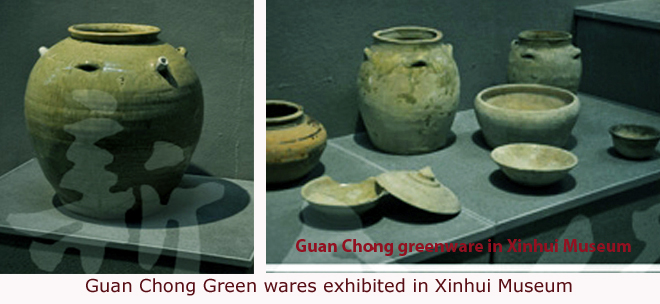
Archaeological excavations revealed that the kilns in Chaozhou Beijiao (潮州北郊) , Chaozhou Beiguan (潮州北关) and Meixian shuiche (梅县水车) also produced green glaze vessel during the Tang Dynasty. They are well potted and has even glaze. Some Chaozhou vessels mainly bowls and jars were found in the Tang Belitung wreck. Compare with Yue ware, the glaze of Chaozhou green ware is thicker, appear more glassy and typically have fine crackles. Ceramic products from Meixian and Chaozhou kilns, which were located near the Hanjiang river (韩江), were transported down the river to the Chaozhou port.

Concluding Comments
Ancient Chinese texts contained fragmentary comments regarding Nanhai ie Southeast Asian region. The Chinese interest in this region was mainly motivated by the desire for exotic goods such as pearls, rhinocerous horn, ivory, tortoise, kingfisher feathers and etec. The Chinese goods used for the exchange were mainly silk, lacquer and gold. In the past, a few pieces of Han lead glazed vessels were purported found in Indoneisa. However archaeological findings in Indonesia showed that Chinese Ceramics only apppeared in significant amount after the 8th century. This is hardly surprising if we study the historical development of Chinese ceramics. Prior to Tang Dynasty, ceramics wares were not widely used in daily lives of the Chinese and a large proportion was produced for burial purposes. This changed after the popularisation of tea culture. Ceramics were found to be a suitable medium for tea drinking vessels. They could also be produced at a relatively low cost. As a result vessels essential for tea drinking such as bowls and ewers were produced in large quantity. Initially, overseas merchants were probably fascinated by the fine quality of the vessels and purchased them as exoctic goods. The vessels were well-received and met the practical needs of the overseas consumers. By the 9th century, Chinese ceramics became a staple in the export trade. The Belitung cargo which was assembled during this historic stage is undeniably the earliest and most important wreck. It answered some of our questions regarding the Tang Dynasty Chinese ceramics assemblage, physical evidence affirming the role of Arab merchants in the maritime trade and the structure of the ship. The wide range of ceramics are also useful references for dating related wares of the period.
...... Return to page 1
Written by: NK Koh (19 Feb 2016)